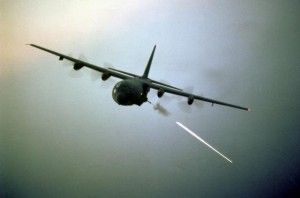US Uses Close Air Support In Libya
The U.S. military dramatically stepped up its assault on Libyan government ground forces over the weekend, launching its first missions with AC-130 flying gunships and A-10 attack aircraft designed to strike enemy ground troops and supply convoys.
The use of the aircraft, during days of heavy fighting in which the momentum seemed to swing in favor of the rebels, demonstrated how allied military forces have been drawn deeper into the chaotic fight in Libya. A mission that initially seemed to revolve around establishing a no-fly zone has become focused on halting advances by government ground forces in and around key coastal cities.
The AC-130s, which fly low and slow over the battlefield and are typically more vulnerable to enemy fire than fast-moving fighter jets, were deployed only after a week of sustained coalition attacks on Libyan government air defenses and radar sites. These aircraft, armed with heavy machine guns and cannons that rake the ground, allow strikes on dug-in Libyan ground forces and convoys in closer proximity to civilians.
The planes are being used to step up pressure on Libyan ground troops, who have retreated from the rebel’s advance and fortified around several cities east of Tripoli, the capital. “Our strategy continues to be to pressure them where we think it’s going to give us the best effect,” said Vice Adm. William Gortney, director of the Pentagon’s Joint Staff, referring to the use of the new aircraft. “The number of the strike sorties that you saw, I think, is a direct result of that.”
Gortney emphasized that the military was not using the planes to facilitate a rebel advance. The Washington Post learned of their deployment last week but withheld reporting the information until their first missions at the request of U.S. military officials.
Military officials consider AC-130s and A-10s well suited to attacks in built-up areas, although their use has led to civilian deaths. Unlike fighter jets and bombers, which typically carry 500- or 1,000-pound bombs, the AC-130s and A-10s deliver more discriminate but still devastating machine-gun fire. “They offer weapons that you can meter against a much smaller area and not risk as much collateral damage,” said retired Air Force Lt. Gen. David A. Deptula, who played a key role in overseeing the initial U.S. attack on Afghanistan in 2002.
AC-130s were used to great effect during the two U.S. offensives in Fallujah, a stronghold of the insurgent group al-Qaeda in Iraq in the early days of the Iraq war. In Afghanistan, the military considers them particularly effective against entrenched militants, and commanders have frequently complained that they are in too short supply. The gunships, developed from a Hercules C-130 transport plane for use in Vietnam, put pilots at greater risk than fighter jets, but they have been used in virtually every U.S. military combat operation since then.
Click here to read more.


